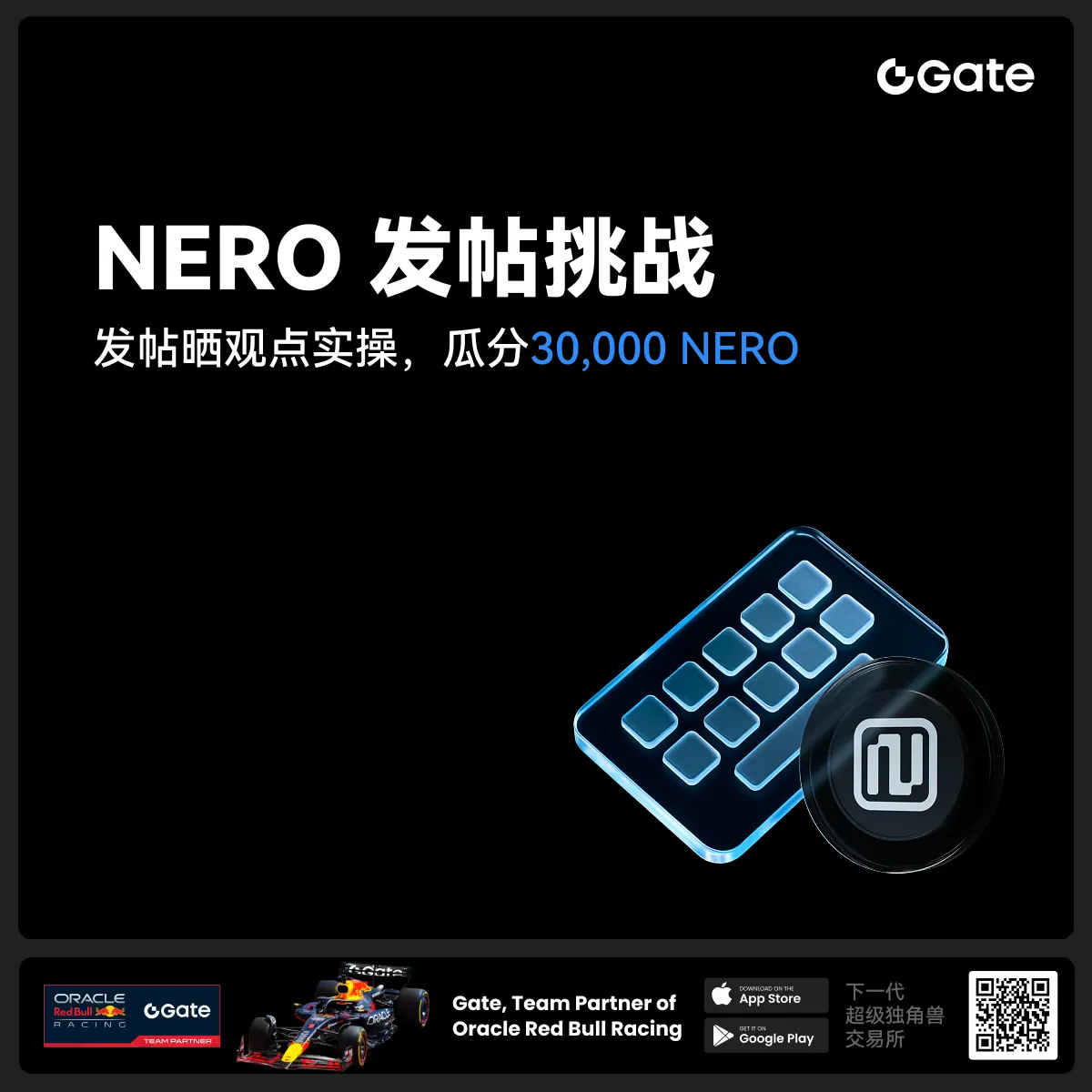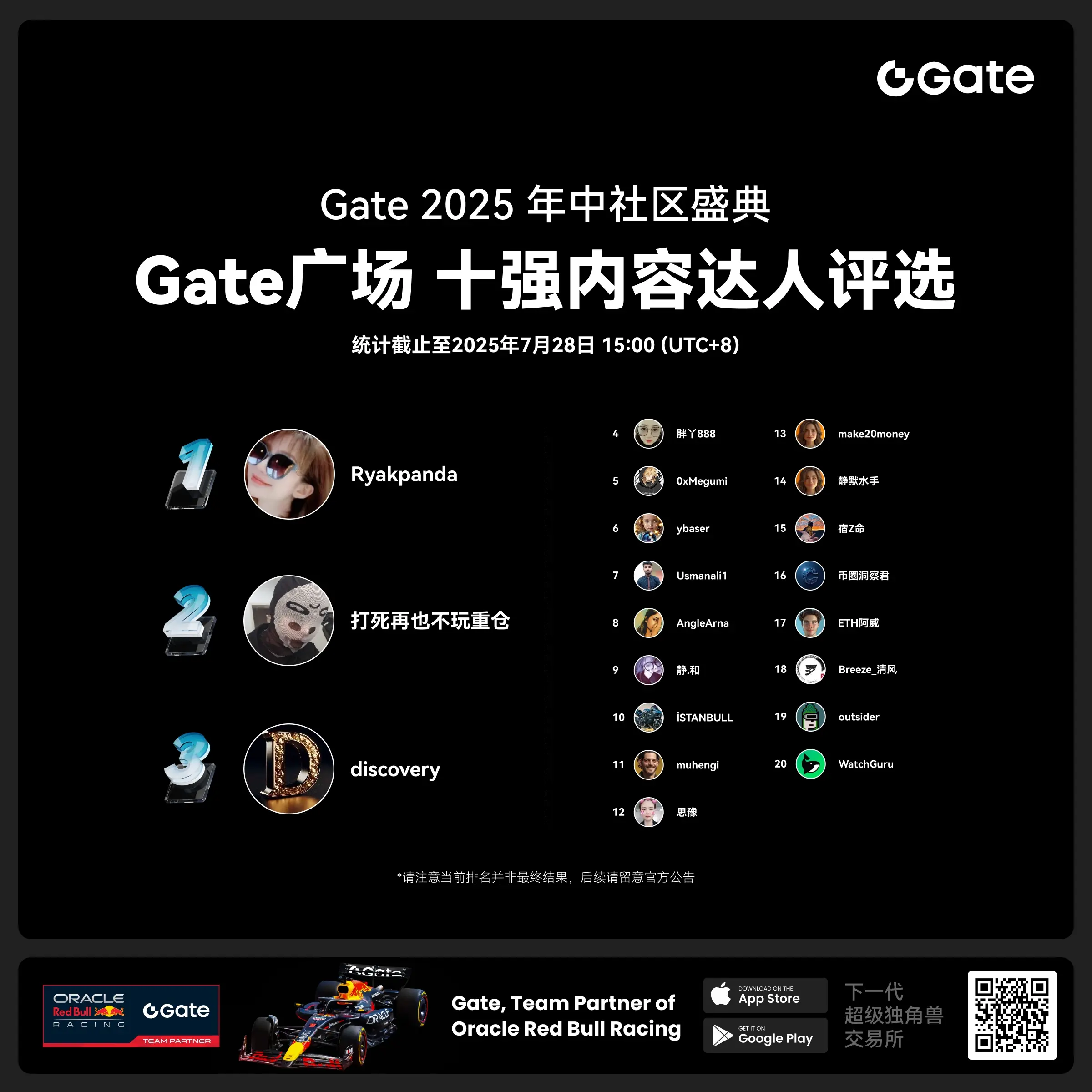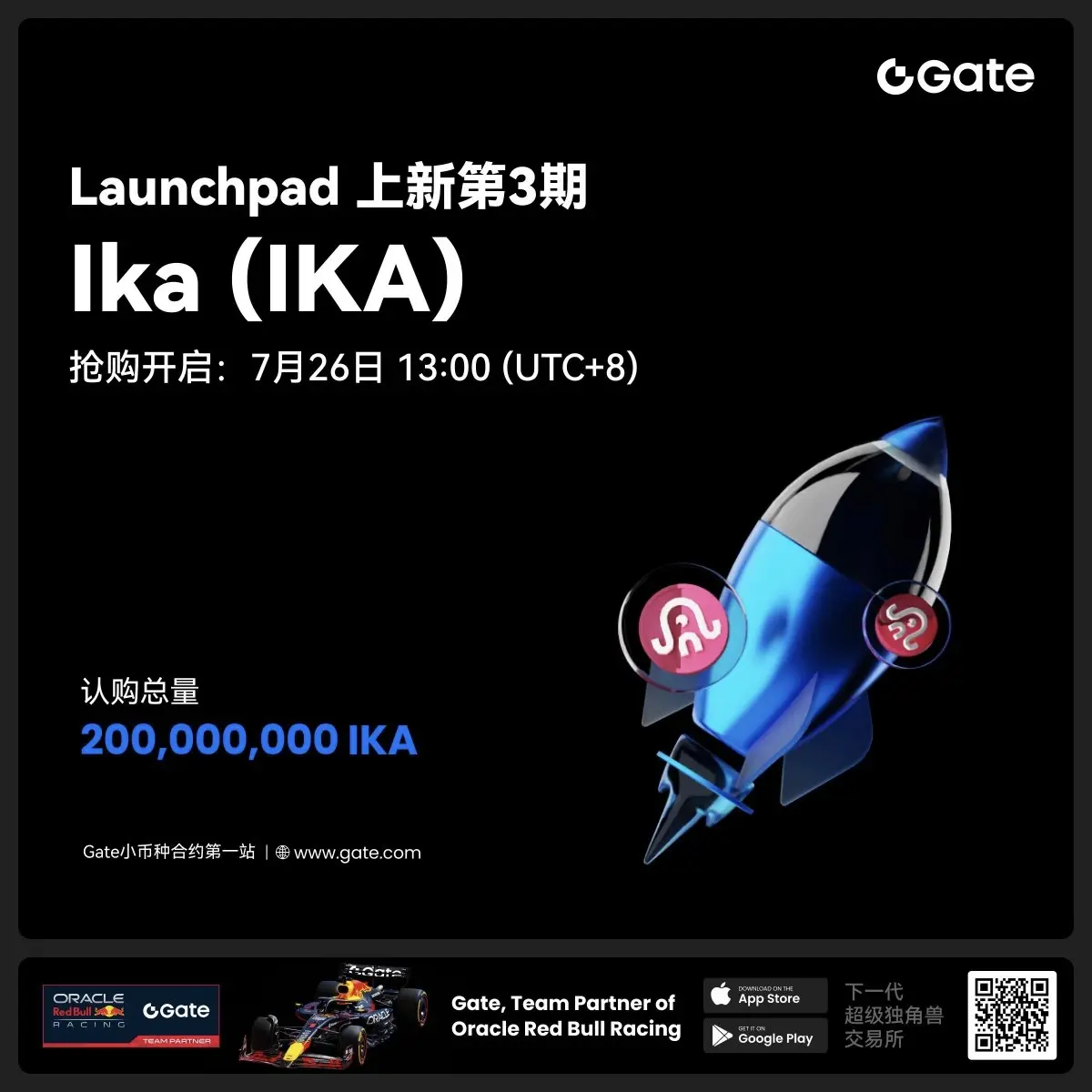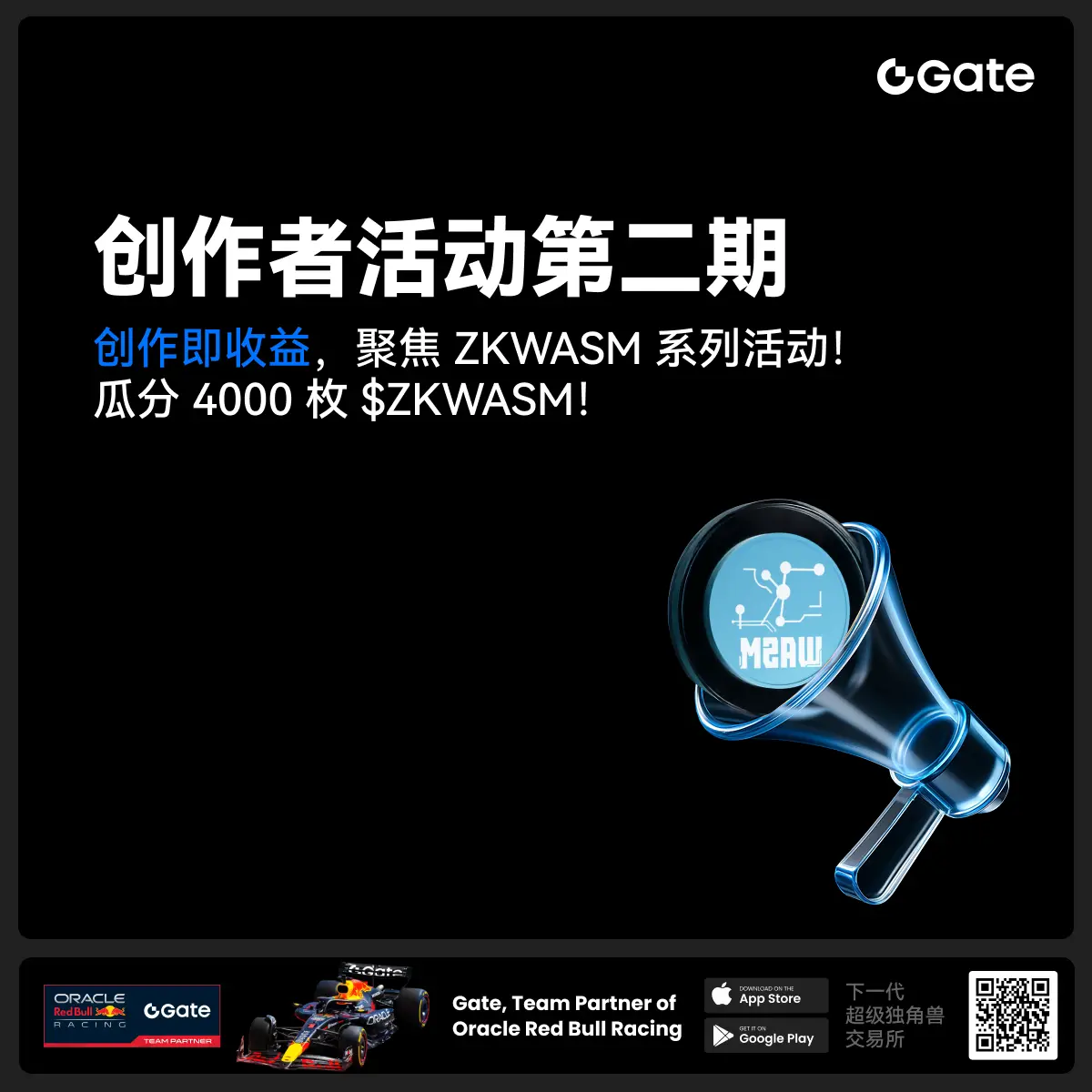- 话题1/3
17k 热度
4k 热度
5k 热度
15k 热度
19k 热度
- 置顶
- 📢 Gate广场 #NERO发帖挑战# 秀观点赢大奖活动火热开启!
Gate NERO生态周来袭!发帖秀出NERO项目洞察和活动实用攻略,瓜分30,000NERO!
💰️ 15位优质发帖用户 * 2,000枚NERO每人
如何参与:
1️⃣ 调研NERO项目
对NERO的基本面、社区治理、发展目标、代币经济模型等方面进行研究,分享你对项目的深度研究。
2️⃣ 参与并分享真实体验
参与NERO生态周相关活动,并晒出你的参与截图、收益图或实用教程。可以是收益展示、简明易懂的新手攻略、小窍门,也可以是行情点位分析,内容详实优先。
3️⃣ 鼓励带新互动
如果你的帖子吸引到他人参与活动,或者有好友评论“已参与/已交易”,将大幅提升你的获奖概率!
NERO热门活动(帖文需附以下活动链接):
NERO Chain (NERO) 生态周:Gate 已上线 NERO 现货交易,为回馈平台用户,HODLer Airdrop、Launchpool、CandyDrop、余币宝已上线 NERO,邀您体验。参与攻略见公告:https://www.gate.com/announcements/article/46284
高质量帖子Tips:
教程越详细、图片越直观、互动量越高,获奖几率越大!
市场见解独到、真实参与经历、有带新互动者,评选将优先考虑。
帖子需原创,字数不少于250字,且需获得至少3条有效互动
- 🎉 亲爱的广场小伙伴们,福利不停,精彩不断!目前广场上这些热门发帖赢奖活动火热进行中,发帖越多,奖励越多,快来GET你的专属好礼吧!🚀
1️⃣ #GateLaunchpad上线IKA# |IKA认购体验
在Gate广场带话题晒出你的IKA Launchpad认购体验,4位幸运分享者讲瓜分$200分享奖池!
详情 👉️ https://www.gate.com/post/status/12566958
2️⃣ #ETH冲击4800# |行情分析预测
大胆发帖预测ETH走势,展示你的市场洞察力!10位幸运用户将平分0.1 ETH 奖励!
详情 👉️ https://www.gate.com/post/status/12322403
3️⃣ #创作者活动第二期# |ZKWASM话题
在广场或推特发布与 ZKWASM 或其交易活动相关的原创内容,瓜分4,000枚ZKWASM!
详情 👉️ https://www.gate.com/post/status/12525794
4️⃣ #Gate广场征文活动第二期# |ERA话题
谈谈你对ERA的观点/体验,参与并推广活动,700 ERA大奖等你赢!
详情 👉️ https://www.gate.com/post/status/12361653
5️⃣ #MBG任务挑战# |MBG话题
分享你对MBG的洞察,积极参与和推广MBG活动,20位小 - 亲爱的广场用户们, #Gate 2025年中社区盛典# 投票中!🔥
🙌 广场内容达人TOP40榜单新鲜出炉!速速围观榜单,为你喜爱的达人疯狂打call吧:
www.gate.com/activities/community-vote
每天完成【广场】互动任务可获得助力值,每投出30助力值即可参与抽奖一次!
iPhone 16 Pro Max 512G、金牛雕塑、潮流运动套装、合约体验券、热门币种等你抽!
助力越多,中奖机率越大,下一个抱走iPhone 16的锦鲤就是你!🧧
别犹豫,带上你的“欧气”,为达人冲榜赢大奖!
https://www.gate.com/announcements/article/45974
- 🎉 Gate 广场 IKA Launchpad 发帖活动来袭!🎉
Gate Launchpad 认购 IKA 最后24小时!晒出你的认购体验,和大家一起分享,每个人都有机会瓜分 $200 奖池!
🎁 4位幸运分享者*$50合约体验券每人!
🧐 如何参与:
1.在广场发帖,带上 #GateLaunchpad上线IKA# 标签
2.晒出你的认购截图 或 分享你的独特认购小窍门/心得或趣事
3.保证帖子大于50字,内容有趣有料,原创,集齐至少3个互动(点赞/评论/转发)
IKA认购链接:https://www.gate.com/launchpad/2336?downgarde=true
活动时间:7月28日 12:00 - 7月30日 24:00 (UTC+8)
赶快加入,分享你的精彩时刻,你就是下一个幸运儿!
- 📢 Gate广场 #创作者活动第二期# 正式开启!
聚焦 ZKWASM 系列活动,分享你的观点,瓜分 4,000 枚 $ZKWASM!
ZKWASM 作为 zk 公链先锋,正在 Gate 平台重磅推广!
三大活动联动上线:Launchpool 认购、CandyDrop 空投、Alpha 专属交易——不要错过!
🎨 活动一:发布广场贴文,赢内容奖励
📅 时间:7月25日 22:00 - 7月29日 22:00(UTC+8)
📌 参与方式:
- 在 Gate 广场发布与 ZKWASM 或其三大活动相关的原创内容(不少于 100 字)
- 添加标签: #创作者活动第二期# #ZKWASM#
- 附本人参与 Launchpool/CandyDrop/Alpha 的截图(如认购、空投或交易)
🏆 奖励设置:
- 一等奖(1名):1000 枚 $ZKWASM
- 二等奖(2名):500 枚 $ZKWASM
- 三等奖(10名):100 枚 $ZKWASM
📋 评选标准:内容质量、互动量、项目相关性,附活动参与截图者优先。
📢 活动二:发推赢传播力奖励
📌 参与方式:
- 在 X(推特)发布与 ZKWASM 或三大活动相关的原创内容(不少于 100 字)
- 添加标签: #ZKWASM # GateSquare
- 填写登记表 👉 https://www.gate.com/quest
Ethereum’s ‘Trustware’ era could push ETH to $15.8K — Consensys
As Ethereum nears its 10th anniversary, blockchain company Consensys is proposing a new way to think about the network’s role in the global economy: as critical infrastructure for what it calls a “trustware” era.
According to Consensys, Ethereum is evolving beyond a smart contract platform into a foundational layer for verifiable, programmable trust in financial systems and beyond.
While the concept remains speculative, Consensys points to Ethereum’s growing share of tokenized assets, stablecoins and decentralized finance as early signals of that shift, further predicting that demand for Ether (ETH) could rise sharply in the coming years.
Jason Linehan, chief strategy officer at Consensys, spoke to Cointelegraph about the network’s “cost-to-corrupt” model, a framework he says could help drive ETH to new highs.
Trustware: Ethereum’s next identity
While not often discussed or measured, trust is behind nearly every economic interaction. According to Consensys, the global economy spends over $9.3 trillion annually on trust infrastructure in insurance, legal systems, auditors, compliance, notaries and go-betweens.
The digital era has enabled a new form of trust — borderless, transparent and enforced by code, allowing strangers to transact with mathematical certainty. Consensys calls this “trustware.”
“Trustware is a new way to talk about the incredible value that Ethereum is already bringing to the economy,” Linehan told Cointelegraph “Value that has been built block by block over the past 10 years through the effort of organizations like the Ethereum Foundation, Consensys, and the global Ethereum developer community.”
As traditional financial institutions recognize the efficiency and value of this type of trust infrastructure, Consensys argues that demand for Ethereum will rise accordingly, driving long-term growth in the value of ETH.
Related: Vitalik Buterin proposes minimalism as key to layer-2 blockchain success
How Trustware reshapes Ethereum’s value proposition
The cost-to-corrupt model is a valuation framework that links the market value of ETH to the security required to protect the economic activity on Ethereum. It operates on a simple premise: The more value Ethereum secures, in the form of stablecoins and other DeFi assets, the more expensive it must be to attack the network.
Using a “cost-to-corrupt” model, Consensys predicts the price of ETH to hit $4,900 by the end of 2025 and $15,800 by 2028. Linehan said the model assumes $1 trillion value in stablecoins, $500 billion in tokenized real-world assets (RWAs), and $300 billion in total value locked (TVL) by 2028, figures he considers conservative.
“There are credible projections of $2 trillion in stablecoins and up to $16 trillion in RWAs by 2028 or 2030,” he said, noting Ethereum’s current dominance in both asset classes.
As of May 31, Ethereum had secured $220 billion in High-Quality Liquid Assets (HQLA) onchain, according to Consensys, significantly outpacing Solana’s $20.3 billion and Avalanche’s $3.7 billion, despite these networks growth over the past years.
“The future will not look like the past… it’s going to be an economy like we’ve never seen, and it will blow the doors off of what we have today. Ethereum makes it possible,” said Linehan.
Atheneum’s architecture of safety and scale
As Ethereum nears its 10th anniversary, it boasts 21 network upgrades and a legacy of foundational innovations, including smart contracts, NFTs, tokens, DeFi, DAOs, oracles, rollups, stablecoins, proof-of-stake and RWAs — all pioneered on its platform.
Its architecture is powered by 1,056,000 validators across 84 countries. Consensys says that while other blockchains may attract specific sectors, like gaming and memecoins, where trustware is less critical, Ethereum is still a prime choice for institutional investors managing billions in global capital
“Agentic finance will mean tokenized RWAs and all other asset classes will be accessed and transacted in thousands of times a second, 24/7/365, by the most sophisticated algorithms we can imagine,” he said
Magazine: TradFi is building Ethereum L2s to tokenize trillions in RWAs — Inside story